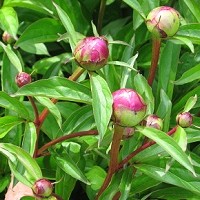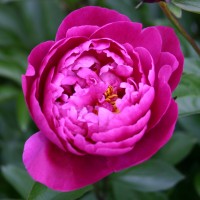Peonies–Masterpieces of May
There are ants on my peonies,” she said to me. “I’ve heard that peonies need ants for the buds to open. Is that true?”
 When I worked at Home Depot, I could guarantee this query at least a dozen times each weekend that the peonies were in bloom. Gardening has its share of pieces of Folk Wisdom and this isn’t one of them.
When I worked at Home Depot, I could guarantee this query at least a dozen times each weekend that the peonies were in bloom. Gardening has its share of pieces of Folk Wisdom and this isn’t one of them.
Peonies can open perfectly well without ants.
The ants are there to take advantage of a reliable dinner. As peonies open, they secrete a sweet sap along the edges of the petals through specialized cells called nectaries. Many flowers have nectaries within the flower to encourage pollination. Some plants like Trumpet Creeper, Hibiscus, Elderberry, and Willow have extrafloral nectaries. Peonies have their extrafloral nectaries along the edges of the buds. As these glands exude the sap, it’s the equivalent of the ice cream truck driving through the neighborhood. Every ant and its uncle come scurrying for a sweet treat.
Should you get rid of the ants? Many soft-hearted and environmentally conscious people say “No.” The ants keep other insects or foraging animals from damaging the blossoms. I am a bit more pragmatic. If the peonies are close to the house, I think beyond peony season. Frankly, I don’t want ants building expansive communities that will become a hungry mob of marauders turning to my kitchen with the inevitable rainfall that occurs when peonies are in full bloom. I also don’t want to bring ants into the house with my cut flowers.
As long as they stay away from my house, I say “Hope you enjoy your meal.” The minute they head toward my home they’ll encounter a barrier treatment of insecticide that will kill them. The peony will have served as kind of a last meal. The smart ants will learn to stay outdoors and find all that nature can provide. The insolent ants will meet their Maker.
To keep from spraying my peonies with insecticide, I submerge the newly opening cut blossoms in a tray of water until the ants float to the surface or I spray them with a gentle shower to wash the ants off with a hose before bringing the peonies inside. A gentle upside-down shake removes excess water and I can enjoy my floral arrangement without inviting unwanted houseguests.
 Peonies enjoy full to part sun, are heavy feeders, and come in singles and doubles as well a variety of colors. They can endure in the same location for decades and reward you with their beauty in the spring and their durable shrub-like foliage until the fall. They require some additional care with respect to planting depth and are best divided in the fall in order to bloom happily. They are some of the oldest cultivated plants for good reason—they are truly among the masterpieces of May.
Peonies enjoy full to part sun, are heavy feeders, and come in singles and doubles as well a variety of colors. They can endure in the same location for decades and reward you with their beauty in the spring and their durable shrub-like foliage until the fall. They require some additional care with respect to planting depth and are best divided in the fall in order to bloom happily. They are some of the oldest cultivated plants for good reason—they are truly among the masterpieces of May.


4 Comments
by same day flowers delivery
On June 2, 2011
I love this site, especially the pictures, do you really take them your self? Throughout The USA we’ve been blessed having a massive wide variety of blooms, by far the most stunning of which are in all likelihood the spring plants. Am I Able To use some of the photos on my weblog? I will backlink any back to here naturally. Amelia
by seminarygal
On June 3, 2011
Hi Amelia, I love spring plants too. Maybe it’s just because the winter makes spring more hopeful.
Some of the pictures are of my garden…for example the peony buds (above) and the bluebells, etc. Some of the photos like the fully open peony above are from a free stock photo web site. When I had the pussy willow photo, I linked back to the article and the rest of his beautiful photos.
When I use photos for the theology articles, most of them are from stock photo web sites. Someday I hope to be a better photographer so I can have all the photos be original to me.
Any that are original to me, backlinking is great. Use them with my blessings. If there are ones that look really professional, you may want to check http://sxc.hu/ which is Stock.XCHNG… and Stockvault which is http://stockvault.net/ . I can usually find suitable photos at one of those and their photos are very nice and many have standard restrictions regarding using in public works.
Blessings to you in your weblog. Barbara <><
by seminarygal
On June 4, 2011
I’ve received three questions about peonies:
(1) When do I cut peonies to bring them inside?
(2) Why don’t my peonies flower?
(3) Why does my peony develop buds that never open?
I cut peonies early in the morning so they will not become stressed and wilt. I select buds that look like a tight scoop of ice cream with a few petals as garnish. That way they’ll be developed enough to fully open inside.
Peonies do not flower for 5 basic reasons. (1) Not old enough–if you bought a packaged plant in cedar shavings, it’s a baby and needs to mature. (2) Not enough sunlight. It needs full to part sun. (3) Fertilizer imbalance. A 30-10-10 (for example) has too high a first number–nitrogen–and will grow great leaves and few flowers. A balanced 12-12-12 or 10-10-10 is far superior. (4) Late spring chill that aborted the buds. Hope for better weather next year. (5) Planted too deep. Do any division or replanting to correct depth in the fall.
Peony buds that fail to develop can be the last buds after the major flushes of bloom are over. They will turn brown and be hollow since the plant exhausted its energies already making blooms. These immature buds came to the party too late.
The other major reason why buds fail to develop is a plant disease called BOTRYTIS which flourishes in damp or shady areas. There are treatments available as sprays and systemics to control botrytis on non-food crops. Tebuconazole, the active ingredient in the Bayer All-in-One for Roses is effective on botyritis spp according to Bayer’s Crop Sciences pages.
by seminarygal
On June 11, 2011
I’ve received another query about cut peonies regarding how to treat them indoors in a bouquet.
I put them in a vase that will not easily be tipped by the heavy heads of peonies as they open. I always use floral preservative in the concentration listed on the package in order to feed the blossoms and to discourage baterial growth in the water.
If you’ve ever thrown out water after a bouquet has died and it has that really awful smell, it’s because diseases can thrive in any sweet solution with no disinfectant. Because there can be a buildup of disease organisms and the disinfectant loses its potency in the face of so much pressure over time, it is wise to replace the solution for maximal life in your floral bouquet.
Other ways to prolong the life of your bouquet would be to keep it away from heat sources and direct sunlight. Both of these overwhelm the plant’s ability to keep itself hydrated and nourished.
Enjoy your bouquet! B<><